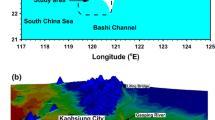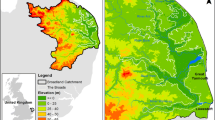Abstract
The hydrodynamic effects of flooding during extreme storm events are the leading cause of structural damage to impacted properties and due to their complexity, it is difficult to accurately estimate structural damage and flood vulnerability. We propose a robust structural damage assessment model that considers the dynamic behavior of flooding coupled with the structural and regional characteristics of buildings by using of a pair hydrodynamic model i.e., the advanced circulation (ADCIRC) and two-dimensional unsteady flow (TUFLOW). Fine-scale inland flooding scenarios were developed to simulate heavily impacted areas of coastal New Jersey in the United States (US) based on the historical storm Hurricane Sandy (2012). The models were calibrated and validated using multiple sets of observed data as well as using several performance metrics. The corresponding Nash–Sutcliffe efficiency (NSE) and R-squared (R2) values were found to be in the range of 0.426–0.81 and 0.56–0.91, respectively, during the ADCIRC calibration process. A spatial comparison with the observed inundation data revealed that the correlation coefficient and root mean square error (RMSE) for the inland flood modelling by TUFLOW were 0.79 and 0.71, respectively, with a 96.49% coefficient of similarity. A structural damage model was developed by combining the hydrodynamic components of flooding with several structural characteristics. In a comparison of the observed and model-simulated damage counts, the results indicate the conservative nature of the damage-prediction model with a mean absolute error (MAE) of 40.26 and RMSE of 58.67. Using a GIS framework, the damage assessment results for a particular type of storm were mapped to illustrate the damage levels of individual properties.







Similar content being viewed by others
References
Amante C, Eakins BW (2009) ETOPO1 1 arc-minute global relief model: procedures, data sources and analysis. US Department of Commerce, National Oceanic and Atmospheric Administration, National Environmental Satellite, Data, and Information Service, National Geophysical Data Center Marine Geology and Geophysics Division 19
Arrighi C et al (2018) Quantification of flood risk mitigation benefits: a building-scale damage assessment through the RASOR platform. J Environ Manag 207:92–104. https://doi.org/10.1016/j.jenvman.2017.11.017
Atoba Kayode O, Brody Samuel D, Highfield Wesley E, Merrell William J (2018) Estimating residential property loss reduction from a proposed coastal barrier system in the Houston-Galveston Region. Nat Hazard Rev 19:05018006. https://doi.org/10.1061/(ASCE)NH.1527-6996.0000297
Bacopoulos P, Hagen SC (2017) The intertidal zones of the South Atlantic Bight and their local and regional influence on astronomical tides. Ocean Model 119:13–34. https://doi.org/10.1016/j.ocemod.2017.09.002
Bellos V, Tsakiris G (2015) Comparing various methods of building representation for 2D flood modelling in built-up areas. Water Resour Manag 29:379–397. https://doi.org/10.1007/s11269-014-0702-3
Bhatt CM, Rao GS, Diwakar PG, Dadhwal VK (2017) Development of flood inundation extent libraries over a range of potential flood levels: a practical framework for quick flood response. Geomat Nat Haz Risk 8:384–401. https://doi.org/10.1080/19475705.2016.1220025
Botts H, Du W, Jeffery TC, Kolk S, Pennycook Z, Suhr L (2013) CoreLogic storm surge report
Cialone MA, Grzegorzewski AS, Mark DJ, Bryant MA, Massey TC (2017) Coastal-storm model development and water-level validation for the North Atlantic coast comprehensive study. J Waterw Port Coast Ocean Eng 143:04017031
Dietrich JC et al (2012) Performance of the unstructured-mesh, SWAN+ ADCIRC model in computing hurricane waves and surge. J Sci Comput 52:468–497
Fahad MGR, Saiful Islam A, Nazari R, Alfi Hasan M, Tarekul Islam G, Bala SK (2018) Regional changes of precipitation and temperature over Bangladesh using bias-corrected multi-model ensemble projections considering high-emission pathways. Int J Climatol 38:1634–1648
Fahad MGR, Nazari R, Bhavsar P, Jalayer M, Karimi M (2019) A decision-support framework for emergency evacuation planning during extreme storm events. Transp Res Part D: Transp Environ. https://doi.org/10.1016/j.trd.2019.09.024
FEMA-MOTF (2014) FEMA modeling task force. Hurricane Sandy impact analysis. Federal Emergency Management Agency Modeling Task Force. https://data.femadata.com/MOTF/. Accessed 5 May 2019
Hallegatte S, Green C, Nicholls RJ, Corfee-Morlot J (2013) Future flood losses in major coastal cities. Nat Clim Chang 3:802–806
Haltas I, Elçi S, Tayfur G (2016) Numerical simulation of flood wave propagation in two-dimensions in densely populated urban areas due to dam break. Water Resour Manag 30:5699–5721
Hatzikyriakou A, Lin N (2017) Simulating storm surge waves for structural vulnerability estimation and flood hazard mapping. Nat Hazards 89:939–962
Hirabayashi Y, Kanae S, Emori S, Oki T, Kimoto M (2008) Global projections of changing risks of floods and droughts in a changing climate. Hydrol Sci J 53:754–772
HUD (2013) Department of Housing and Urban Development United States Hurricane Sandy Damage Estimates by Block Group, 2012. http://purl.stanford.edu/jp095bg5089. Accessed 5 May 2019
Jamali B, Löwe R, Bach PM, Urich C, Arnbjerg-Nielsen K, Deletic A (2018) A rapid urban flood inundation and damage assessment model. J Hydrol 564:1085–1098
Jhong B-C, Huang J, Tung C-P (2019) Spatial assessment of climate risk for investigating climate adaptation strategies by evaluating spatial-temporal variability of extreme precipitation. Water Resour Manag:1–24
Landsea CW, Franklin JL (2013) Atlantic hurricane database uncertainty and presentation of a new database format. Mon Weather Rev 141:3576–3592
McGrath H, El Ezz AA, Nastev M (2019) Probabilistic depth–damage curves for assessment of flood-induced building losses. Nat Hazards:1–14
Motamedi M, Iranmanesh A, Nazari R (2018) Quantitative assessment of resilience for earthen structures using coupled plasticity-damage model. Eng Struct 172:700–711
Neill SP, Hashemi MR (2018) Fundamentals of ocean renewable energy: generating electricity from the sea. Academic, London
NJ-MODIV (2018) Parcels and MOD-IV composite of New Jersey. NJ Office of Information Technology, Office of GIS (NJOGIS). https://njgin.nj.gov/njgin/edata/parcels/index.html#!/. Accessed 5 May 2019
NYC SIRR (2013) New York city special initiative for rebuilding and resiliency PlaNYC: a stronger, More Resilient New York. City of New York. http://smedia.nyc.gov/agencies/sirr/SIRR_singles_Lo_res.pdf. Accessed 5 May 2019
Pasterick ET (1998) The national flood insurance program. Paying the price: the status and role of insurance against natural disasters in the United States. Joseph Henry Press, Washington D.C.
Pistrika AK, Jonkman SN (2010) Damage to residential buildings due to flooding of New Orleans after hurricane Katrina. Nat Hazards 54:413–434
Sahoo B, Jose F, Bhaskaran PK (2019) Hydrodynamic response of Bahamas archipelago to storm surge and hurricane generated waves–A case study for Hurricane Joaquin. Ocean Eng 184:227–238
Saleh F, Ramaswamy V, Wang Y, Georgas N, Blumberg A, Pullen J (2017) A multi-scale ensemble-based framework for forecasting compound coastal-riverine flooding: The Hackensack-Passaic watershed and Newark Bay. Adv Water Resour 110:371–386
Selvanathan S, Sreetharan M, Lawler S, Rand K, Choi J, Mampara M (2018) A framework to develop nationwide flooding extents using climate models and assess forecast potential for flood resilience. JAWRA Journal of the American Water Resources Association 54:90–103
Simm JD, Guise A, Robbins D, Engle J (2015) US North Atlantic coast comprehensive study: resilient adaptation to increasing risk coastal management, 7–9 The Netherlands
Söderholm K, Pihlajamäki M, Dubrovin T, Veijalainen N, Vehviläinen B, Marttunen M (2018) Collaborative planning in adaptive flood risk management under climate change. Water Resour Manag 32:1383–1397
Song JY, Chung E-S (2016) Robustness, uncertainty and sensitivity analyses of the TOPSIS method for quantitative climate change vulnerability: a case study of flood damage. Water Resour Manag 30:4751–4771
SRPR (2012) Strategic recovery planning report post Sandy planning assistance Grant program. New Jersey Department of Community Affairs (NJDCA) https://www.nj.gov/dca/services/lps/SRPRs/Brick_SRPR.pdf. Accessed 5 May 2019
Stelling GS (1984) On the construction of computational methods for shallow water flow problems. Rijkswaterstaat Com 35:1–226
WBM B (2008) TUFLOW User Manual-GIS Based 2d/1d Hydrodynamic Modelling Report2008. TUFLOW. https://www.tuflow.com/Tuflow%20Documentation.aspx.
Wildemeersch S, Goderniaux P, Orban P, Brouyère S, Dassargues A (2014) Assessing the effects of spatial discretization on large-scale flow model performance and prediction uncertainty. J Hydrol 510:10–25
Wing OE, Sampson CC, Bates PD, Quinn N, Smith AM, Neal JC (2019) A flood inundation forecast of hurricane Harvey using a continental-scale 2D hydrodynamic model. J Hydrol X 4:100039
Zhang W, Li J, Chen Y, Li Y (2019) A surrogate-based optimization design and uncertainty analysis for urban flood mitigation. Water Resour Manag:1–14
Zischg AP, Mosimann M, Bernet DB, Röthlisberger V (2018) Validation of 2D flood models with insurance claims. J Hydrol 557:350–361
Acknowledgements
This work was supported by the New Jersey Department of Community Affairs (NJDCA) from Super-storm Sandy Community Development Block Grant Disaster Recovery (CDBG-DR).
Author information
Authors and Affiliations
Corresponding author
Ethics declarations
Conflict of Interest
None.
Additional information
Publisher’s Note
Springer Nature remains neutral with regard to jurisdictional claims in published maps and institutional affiliations.
Rights and permissions
About this article
Cite this article
Fahad, M.G.R., Nazari, R., Motamedi, M.H. et al. Coupled Hydrodynamic and Geospatial Model for Assessing Resiliency of Coastal Structures under Extreme Storm Scenarios. Water Resour Manage 34, 1123–1138 (2020). https://doi.org/10.1007/s11269-020-02490-y
Received:
Accepted:
Published:
Issue Date:
DOI: https://doi.org/10.1007/s11269-020-02490-y




